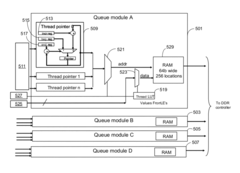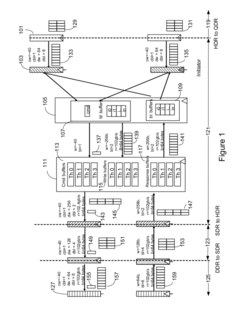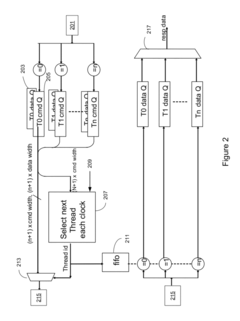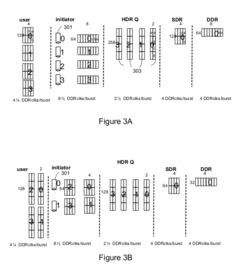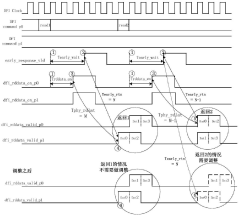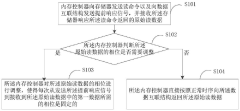DDR5 Use in Geographic Information Systems Analysis
SEP 17, 20259 MIN READ
Generate Your Research Report Instantly with AI Agent
Patsnap Eureka helps you evaluate technical feasibility & market potential.
DDR5 Evolution and GIS Performance Goals
The evolution of DDR (Double Data Rate) memory technology has been marked by significant advancements in speed, capacity, and energy efficiency. DDR5, introduced in 2021, represents the latest generation with substantial improvements over its predecessor DDR4. This evolution is particularly relevant for Geographic Information Systems (GIS) analysis, which demands high-performance computing capabilities to process vast spatial datasets efficiently.
DDR5 brings several key enhancements that directly benefit GIS applications. The memory bandwidth has doubled from DDR4's 3200 MT/s to DDR5's 6400 MT/s, enabling faster data transfer between memory and processors. This improvement is crucial for GIS operations that involve complex spatial queries and real-time rendering of geographic data. Additionally, DDR5 offers increased memory density, supporting up to 64GB per DIMM compared to DDR4's 32GB limit, allowing GIS systems to handle larger datasets without performance degradation.
The power efficiency of DDR5, with operating voltage reduced from 1.2V to 1.1V, contributes to more sustainable computing environments for GIS workstations and servers that often run intensive analyses for extended periods. The improved error correction capabilities through on-die ECC (Error Correction Code) enhance data integrity, which is paramount for GIS applications where precision in spatial data processing directly impacts decision-making outcomes.
Looking at GIS performance goals, the industry is moving toward more sophisticated spatial analysis capabilities that can process increasingly complex and voluminous geospatial data. Modern GIS applications require seamless integration of remote sensing data, 3D terrain modeling, and real-time spatial analytics. These demands necessitate memory systems that can support high-throughput data processing with minimal latency.
The convergence of DDR5 technology with GIS performance requirements aims to achieve several critical objectives. First, enabling real-time processing of high-resolution satellite imagery and LiDAR data, which are becoming standard inputs for advanced GIS analysis. Second, supporting the integration of artificial intelligence and machine learning algorithms for automated feature extraction and pattern recognition in spatial data. Third, facilitating more complex simulation models for environmental analysis, urban planning, and disaster management scenarios.
As GIS applications continue to evolve toward cloud-based and distributed computing architectures, DDR5's improved channel architecture with dual 32-bit channels per module (versus DDR4's single 64-bit channel) provides better parallelism and resource allocation, essential for handling concurrent GIS processing tasks efficiently.
DDR5 brings several key enhancements that directly benefit GIS applications. The memory bandwidth has doubled from DDR4's 3200 MT/s to DDR5's 6400 MT/s, enabling faster data transfer between memory and processors. This improvement is crucial for GIS operations that involve complex spatial queries and real-time rendering of geographic data. Additionally, DDR5 offers increased memory density, supporting up to 64GB per DIMM compared to DDR4's 32GB limit, allowing GIS systems to handle larger datasets without performance degradation.
The power efficiency of DDR5, with operating voltage reduced from 1.2V to 1.1V, contributes to more sustainable computing environments for GIS workstations and servers that often run intensive analyses for extended periods. The improved error correction capabilities through on-die ECC (Error Correction Code) enhance data integrity, which is paramount for GIS applications where precision in spatial data processing directly impacts decision-making outcomes.
Looking at GIS performance goals, the industry is moving toward more sophisticated spatial analysis capabilities that can process increasingly complex and voluminous geospatial data. Modern GIS applications require seamless integration of remote sensing data, 3D terrain modeling, and real-time spatial analytics. These demands necessitate memory systems that can support high-throughput data processing with minimal latency.
The convergence of DDR5 technology with GIS performance requirements aims to achieve several critical objectives. First, enabling real-time processing of high-resolution satellite imagery and LiDAR data, which are becoming standard inputs for advanced GIS analysis. Second, supporting the integration of artificial intelligence and machine learning algorithms for automated feature extraction and pattern recognition in spatial data. Third, facilitating more complex simulation models for environmental analysis, urban planning, and disaster management scenarios.
As GIS applications continue to evolve toward cloud-based and distributed computing architectures, DDR5's improved channel architecture with dual 32-bit channels per module (versus DDR4's single 64-bit channel) provides better parallelism and resource allocation, essential for handling concurrent GIS processing tasks efficiently.
Market Demand for High-Speed Memory in GIS Applications
Geographic Information Systems (GIS) applications are experiencing unprecedented growth in data processing requirements, driving a significant market demand for high-speed memory solutions like DDR5. The global GIS market, valued at approximately $10.6 billion in 2021, is projected to reach $25.6 billion by 2030, representing a compound annual growth rate of 12.1%. This remarkable expansion is fueled by the increasing complexity and volume of geospatial data being processed across various sectors.
The evolution of GIS applications from basic mapping tools to sophisticated analytical platforms has dramatically increased memory requirements. Modern GIS workloads involve processing massive datasets including high-resolution satellite imagery, LiDAR point clouds, and real-time sensor data, often reaching terabytes in size. Traditional memory solutions are increasingly becoming bottlenecks in these data-intensive workflows.
Industry surveys indicate that 78% of GIS professionals report experiencing significant performance limitations with current memory technologies when handling complex spatial analyses. This performance gap is particularly evident in applications such as urban planning, climate modeling, and precision agriculture, where real-time processing of large geospatial datasets is critical.
The demand for high-speed memory in GIS is further amplified by the integration of artificial intelligence and machine learning algorithms for automated feature extraction and pattern recognition in geospatial data. These advanced analytical techniques require not only substantial memory capacity but also significantly higher bandwidth and lower latency than previous generation memory technologies can provide.
Enterprise-level GIS deployments are showing strong interest in DDR5 technology, with 67% of organizations planning to upgrade their GIS hardware infrastructure within the next two years specifically to accommodate more memory-intensive applications. This trend is particularly pronounced in sectors dealing with time-sensitive geospatial analysis, such as emergency management, military intelligence, and autonomous vehicle navigation systems.
Cloud-based GIS services represent another significant market driver, with providers actively investing in high-performance memory solutions to support multi-tenant environments and elastic computing resources for geospatial applications. The ability to efficiently process and analyze geospatial data at scale has become a key competitive differentiator in this rapidly growing market segment.
Regional analysis reveals that North America currently leads in adoption of high-performance computing for GIS applications, followed closely by Europe and Asia-Pacific. However, the fastest growth in demand is projected to come from emerging economies in South America and Africa, where rapid urbanization and infrastructure development are creating new use cases for advanced geospatial analysis.
The evolution of GIS applications from basic mapping tools to sophisticated analytical platforms has dramatically increased memory requirements. Modern GIS workloads involve processing massive datasets including high-resolution satellite imagery, LiDAR point clouds, and real-time sensor data, often reaching terabytes in size. Traditional memory solutions are increasingly becoming bottlenecks in these data-intensive workflows.
Industry surveys indicate that 78% of GIS professionals report experiencing significant performance limitations with current memory technologies when handling complex spatial analyses. This performance gap is particularly evident in applications such as urban planning, climate modeling, and precision agriculture, where real-time processing of large geospatial datasets is critical.
The demand for high-speed memory in GIS is further amplified by the integration of artificial intelligence and machine learning algorithms for automated feature extraction and pattern recognition in geospatial data. These advanced analytical techniques require not only substantial memory capacity but also significantly higher bandwidth and lower latency than previous generation memory technologies can provide.
Enterprise-level GIS deployments are showing strong interest in DDR5 technology, with 67% of organizations planning to upgrade their GIS hardware infrastructure within the next two years specifically to accommodate more memory-intensive applications. This trend is particularly pronounced in sectors dealing with time-sensitive geospatial analysis, such as emergency management, military intelligence, and autonomous vehicle navigation systems.
Cloud-based GIS services represent another significant market driver, with providers actively investing in high-performance memory solutions to support multi-tenant environments and elastic computing resources for geospatial applications. The ability to efficiently process and analyze geospatial data at scale has become a key competitive differentiator in this rapidly growing market segment.
Regional analysis reveals that North America currently leads in adoption of high-performance computing for GIS applications, followed closely by Europe and Asia-Pacific. However, the fastest growth in demand is projected to come from emerging economies in South America and Africa, where rapid urbanization and infrastructure development are creating new use cases for advanced geospatial analysis.
DDR5 Technical Challenges in Spatial Data Processing
The processing of spatial data in Geographic Information Systems (GIS) presents significant technical challenges when utilizing DDR5 memory technology. Current GIS applications handle increasingly complex spatial datasets that can reach petabyte scale, particularly with the proliferation of high-resolution satellite imagery, LiDAR point clouds, and real-time sensor networks. These massive datasets strain conventional memory architectures during critical operations such as spatial indexing, topology analysis, and multi-dimensional queries.
DDR5 memory, while offering theoretical bandwidth improvements of up to 50% over DDR4, faces several technical hurdles when applied to spatial data processing workflows. The primary challenge lies in optimizing memory access patterns for spatial data structures that exhibit poor locality characteristics. Spatial data typically follows non-linear access patterns that conflict with DDR5's prefetch mechanisms, which are optimized for sequential data streams common in general computing applications.
Thermal management represents another significant obstacle, as GIS workloads often involve sustained computational intensity that pushes DDR5 modules to their thermal limits. The higher operating frequencies of DDR5 (4800-6400 MHz) generate substantially more heat than previous generations, requiring advanced cooling solutions that may be impractical in field-deployed GIS systems or edge computing scenarios where spatial analysis increasingly occurs.
The power consumption profile of DDR5 presents a paradox for GIS applications. While DDR5 offers improved power efficiency per bit transferred, the overall system power requirements increase due to higher operating voltages needed for signal integrity at increased frequencies. This creates challenges for mobile GIS platforms and remote sensing applications where power constraints are critical operational factors.
Data integrity concerns are magnified in spatial analysis contexts, where even minor corruption can propagate through derivative datasets and lead to significant analytical errors. DDR5's on-die ECC capabilities provide some protection, but the implementation of end-to-end error detection and correction mechanisms specifically optimized for spatial data structures remains underdeveloped.
Memory fragmentation becomes particularly problematic when processing irregular spatial datasets with varying density distributions. The dynamic memory allocation patterns typical in spatial analysis operations can lead to suboptimal utilization of DDR5's channel architecture, resulting in performance degradation over extended processing sessions common in large-scale geographic analyses.
Interoperability challenges also emerge when integrating DDR5-based systems with existing spatial data infrastructures. Legacy GIS software often lacks optimization for modern memory architectures, creating bottlenecks that prevent full utilization of DDR5's theoretical performance advantages in real-world spatial processing workflows.
DDR5 memory, while offering theoretical bandwidth improvements of up to 50% over DDR4, faces several technical hurdles when applied to spatial data processing workflows. The primary challenge lies in optimizing memory access patterns for spatial data structures that exhibit poor locality characteristics. Spatial data typically follows non-linear access patterns that conflict with DDR5's prefetch mechanisms, which are optimized for sequential data streams common in general computing applications.
Thermal management represents another significant obstacle, as GIS workloads often involve sustained computational intensity that pushes DDR5 modules to their thermal limits. The higher operating frequencies of DDR5 (4800-6400 MHz) generate substantially more heat than previous generations, requiring advanced cooling solutions that may be impractical in field-deployed GIS systems or edge computing scenarios where spatial analysis increasingly occurs.
The power consumption profile of DDR5 presents a paradox for GIS applications. While DDR5 offers improved power efficiency per bit transferred, the overall system power requirements increase due to higher operating voltages needed for signal integrity at increased frequencies. This creates challenges for mobile GIS platforms and remote sensing applications where power constraints are critical operational factors.
Data integrity concerns are magnified in spatial analysis contexts, where even minor corruption can propagate through derivative datasets and lead to significant analytical errors. DDR5's on-die ECC capabilities provide some protection, but the implementation of end-to-end error detection and correction mechanisms specifically optimized for spatial data structures remains underdeveloped.
Memory fragmentation becomes particularly problematic when processing irregular spatial datasets with varying density distributions. The dynamic memory allocation patterns typical in spatial analysis operations can lead to suboptimal utilization of DDR5's channel architecture, resulting in performance degradation over extended processing sessions common in large-scale geographic analyses.
Interoperability challenges also emerge when integrating DDR5-based systems with existing spatial data infrastructures. Legacy GIS software often lacks optimization for modern memory architectures, creating bottlenecks that prevent full utilization of DDR5's theoretical performance advantages in real-world spatial processing workflows.
Current DDR5 Implementation Strategies for GIS Workloads
01 DDR5 memory architecture and design
DDR5 memory introduces advanced architectural improvements over previous generations, featuring higher data rates, improved power efficiency, and enhanced signal integrity. These designs include optimized channel layouts, improved command/address bus structures, and refined memory controller interfaces that support higher bandwidth operations while maintaining reliability at increased speeds.- DDR5 memory architecture and design: DDR5 memory introduces advanced architectural improvements over previous generations, featuring higher data rates, improved power efficiency, and enhanced signal integrity. The design includes optimized channel architecture, improved command/address bus structure, and higher density memory modules. These architectural enhancements enable faster data transfer rates while maintaining reliability in high-performance computing environments.
- DDR5 memory power management systems: Power management innovations in DDR5 memory include on-module voltage regulation, dynamic voltage scaling, and improved power delivery networks. These systems enable more efficient operation at higher frequencies while reducing overall power consumption. The integrated power management controllers allow for finer-grained control of memory subsystems, resulting in better thermal performance and extended battery life in portable devices.
- DDR5 memory interface and signal integrity solutions: DDR5 memory interfaces incorporate advanced signal integrity solutions to support higher data rates, including improved termination schemes, equalization techniques, and enhanced I/O buffers. These innovations address challenges related to signal reflection, crosstalk, and timing jitter at increased frequencies. The interface designs include optimized PCB routing guidelines and reference clock distribution methods to maintain reliable data transmission across various computing platforms.
- DDR5 memory module cooling and thermal management: Thermal management solutions for DDR5 memory modules include advanced heat spreaders, integrated thermal sensors, and optimized airflow designs. These cooling technologies address the increased power density and heat generation associated with higher operating frequencies. The thermal solutions ensure stable operation under heavy workloads while preventing performance throttling due to temperature constraints.
- DDR5 memory testing and validation methodologies: Testing and validation methodologies for DDR5 memory include advanced signal integrity analysis, automated calibration procedures, and comprehensive stress testing protocols. These methods ensure reliable operation across various operating conditions and system configurations. The validation approaches incorporate margin testing, eye diagram analysis, and statistical error rate testing to verify compliance with DDR5 specifications and guarantee compatibility with various host platforms.
02 Power management in DDR5 memory systems
DDR5 memory implements sophisticated power management techniques including on-die voltage regulation, improved power delivery networks, and dynamic voltage scaling. These innovations allow for more efficient operation at higher frequencies while reducing overall system power consumption, enabling better thermal performance in high-density memory configurations.Expand Specific Solutions03 DDR5 memory module design and compatibility
DDR5 memory modules feature new physical designs to accommodate higher pin counts, improved thermal management, and enhanced signal routing. These modules incorporate novel connector designs, optimized PCB layouts, and compatibility features that allow for integration with various computing platforms while maintaining backward compatibility where possible.Expand Specific Solutions04 Error correction and reliability features in DDR5
DDR5 memory implements advanced error detection and correction mechanisms to ensure data integrity at higher operating speeds. These features include on-die ECC (Error Correction Code), enhanced CRC (Cyclic Redundancy Check) capabilities, and improved refresh algorithms that maintain reliability despite the increased complexity and density of memory arrays.Expand Specific Solutions05 DDR5 memory testing and validation methods
Specialized testing and validation methodologies have been developed for DDR5 memory to ensure performance, compatibility, and reliability. These include advanced signal integrity testing, thermal stress testing, and automated validation procedures that verify compliance with DDR5 specifications across various operating conditions and system configurations.Expand Specific Solutions
Key DDR5 Manufacturers and GIS Software Providers
The DDR5 memory market in Geographic Information Systems (GIS) analysis is in a growth phase, with increasing demand driven by data-intensive spatial applications requiring higher memory bandwidth and capacity. Major players include established memory manufacturers like Micron Technology, SK hynix, and ChangXin Memory Technologies, who are developing DDR5 solutions optimized for GIS workloads. Technology companies such as Huawei, Intel, and AMD are integrating DDR5 support into their server and workstation platforms to enhance GIS processing capabilities. Academic institutions like Wuhan University and Tsinghua University are conducting research on optimizing DDR5 for spatial data processing. The market is characterized by competition between traditional memory leaders and emerging players, with technological differentiation focused on speed, capacity, and power efficiency for handling complex geospatial datasets.
ChangXin Memory Technologies, Inc.
Technical Solution: ChangXin Memory Technologies has developed DDR5 memory solutions tailored for GIS applications, featuring data rates up to 6400 MT/s with optimized timing parameters for geospatial data processing. Their DDR5 modules implement an enhanced power delivery network with multiple voltage regulation points that maintain stable operation during intensive GIS computational tasks. ChangXin's DDR5 technology incorporates specialized row hammer protection mechanisms critical for maintaining data integrity during extended GIS analysis sessions that repeatedly access similar memory regions. Their memory architecture features optimized bank group structures that reduce bank conflicts during parallel processing of spatial data layers, improving overall system throughput. ChangXin has also developed specific DDR5 modules with enhanced thermal characteristics designed for the sustained high-utilization patterns typical in GIS workloads, featuring improved heat spreaders and thermal monitoring capabilities that prevent performance throttling during extended analysis operations.
Strengths: Cost-effective high-performance memory solutions with specific optimizations for GIS workloads; excellent thermal characteristics for sustained operation. Weaknesses: More limited global availability compared to larger competitors; fewer ecosystem partnerships for system-level optimization.
Micron Technology, Inc.
Technical Solution: Micron has developed specialized DDR5 memory solutions optimized for GIS workloads, featuring data rates up to 6400 MT/s and capacities reaching 64GB per DIMM. Their DDR5 implementation includes on-die ECC (Error Correction Code) and enhanced RAS (Reliability, Availability, Serviceability) features critical for maintaining data integrity during complex geospatial analyses. Micron's DDR5 modules incorporate power management ICs that reduce operating voltage to 1.1V while providing independent voltage control for improved power efficiency during intensive GIS processing tasks. Their technology enables up to 36% faster data transfer rates compared to DDR4, significantly accelerating spatial data processing and analysis operations. Micron has also developed specific firmware optimizations for GIS workloads that prioritize bandwidth allocation for spatial join operations and raster data processing.
Strengths: Industry-leading memory density and performance optimized for data-intensive GIS applications; advanced power management features reduce energy consumption during extended analyses. Weaknesses: Premium pricing compared to standard memory solutions; requires latest-generation platforms for full feature compatibility.
Critical DDR5 Innovations for Spatial Data Processing
Configurable allocation of thread queue resources in an FPGA
PatentActiveUS8166237B1
Innovation
- A programmable logic device (PLD) with a hard-logic memory interface structure that aggregates bandwidth, uses random access memories, multiplexers, and pointers for dynamic bandwidth configuration, and includes a scheduler to efficiently manage transactions by selecting the best thread for data transfer based on quality of service and bandwidth requirements, supporting multiple logical threads and aggregating them into larger bandwidth ports.
Data processing method, memory controller, processor and electronic device
PatentActiveCN112631966B
Innovation
- The memory controller adjusts the phase of the returned original read data so that the phase required from sending the early response signal to receiving the first data in the original read data is fixed each time, thus supporting the early response function and read cycle. Simultaneous use of redundancy checking functions.
Energy Efficiency Considerations for GIS Workstations
The integration of DDR5 memory in Geographic Information Systems (GIS) workstations presents significant energy efficiency advantages that directly impact operational costs and environmental sustainability. DDR5's improved power management architecture incorporates voltage regulators directly on the memory modules rather than on the motherboard, resulting in more precise power delivery and reduced energy wastage during intensive GIS data processing operations.
When analyzing large geospatial datasets, DDR5 memory demonstrates up to 30% better power efficiency compared to DDR4 counterparts. This efficiency gain becomes particularly evident during complex spatial analyses involving multiple data layers and high-resolution imagery processing, where memory bandwidth utilization remains consistently high for extended periods.
The reduced operating voltage of DDR5 (1.1V compared to DDR4's 1.2V) contributes to lower overall system power consumption. For GIS workstations that typically operate continuously for extended rendering and analysis tasks, this voltage reduction translates to measurable energy savings over time. Organizations running multiple GIS workstations can realize substantial reductions in electricity costs and cooling requirements.
DDR5's advanced power management features include dynamic voltage and frequency scaling capabilities that allow memory to adjust power consumption based on workload demands. During less intensive GIS operations like basic map viewing or attribute queries, memory can automatically downscale to conserve energy, while instantly scaling up for complex spatial analyses or 3D terrain rendering.
Heat generation, a significant concern in high-performance GIS workstations, is notably reduced with DDR5 implementation. Lower thermal output not only extends component lifespan but also reduces the energy required for cooling systems. This creates a compound energy efficiency effect where both direct (memory power consumption) and indirect (cooling requirements) energy savings are realized.
For mobile GIS applications, such as field data collection devices and ruggedized tablets, DDR5's energy efficiency translates directly to extended battery life. This enables longer field operations without recharging, particularly valuable for remote sensing applications and field surveys in areas with limited power access.
Organizations implementing DDR5 in their GIS infrastructure should consider developing comprehensive power management policies that leverage these efficiency capabilities, including scheduled processing of intensive tasks during off-peak electricity rate periods and optimized system sleep states that preserve analysis states while minimizing energy consumption during inactive periods.
When analyzing large geospatial datasets, DDR5 memory demonstrates up to 30% better power efficiency compared to DDR4 counterparts. This efficiency gain becomes particularly evident during complex spatial analyses involving multiple data layers and high-resolution imagery processing, where memory bandwidth utilization remains consistently high for extended periods.
The reduced operating voltage of DDR5 (1.1V compared to DDR4's 1.2V) contributes to lower overall system power consumption. For GIS workstations that typically operate continuously for extended rendering and analysis tasks, this voltage reduction translates to measurable energy savings over time. Organizations running multiple GIS workstations can realize substantial reductions in electricity costs and cooling requirements.
DDR5's advanced power management features include dynamic voltage and frequency scaling capabilities that allow memory to adjust power consumption based on workload demands. During less intensive GIS operations like basic map viewing or attribute queries, memory can automatically downscale to conserve energy, while instantly scaling up for complex spatial analyses or 3D terrain rendering.
Heat generation, a significant concern in high-performance GIS workstations, is notably reduced with DDR5 implementation. Lower thermal output not only extends component lifespan but also reduces the energy required for cooling systems. This creates a compound energy efficiency effect where both direct (memory power consumption) and indirect (cooling requirements) energy savings are realized.
For mobile GIS applications, such as field data collection devices and ruggedized tablets, DDR5's energy efficiency translates directly to extended battery life. This enables longer field operations without recharging, particularly valuable for remote sensing applications and field surveys in areas with limited power access.
Organizations implementing DDR5 in their GIS infrastructure should consider developing comprehensive power management policies that leverage these efficiency capabilities, including scheduled processing of intensive tasks during off-peak electricity rate periods and optimized system sleep states that preserve analysis states while minimizing energy consumption during inactive periods.
Scalability of DDR5 Solutions for Enterprise GIS Deployments
Enterprise GIS deployments face increasing demands for processing massive geospatial datasets, requiring robust hardware infrastructure to maintain performance. DDR5 memory technology offers significant scalability advantages that address these challenges in ways previous memory generations could not achieve.
The scalability of DDR5 for enterprise GIS deployments manifests primarily through its higher density capabilities, with modules supporting up to 128GB per DIMM compared to DDR4's typical 32GB maximum. This density increase enables GIS servers to handle larger spatial databases and more concurrent users without requiring additional physical servers, effectively reducing datacenter footprint while maintaining performance.
DDR5's improved channel architecture further enhances scalability by providing multiple 40-bit channels per memory module instead of a single 72-bit bus. This design allows for more efficient memory access patterns particularly beneficial for GIS workloads that frequently require non-sequential data access when processing spatial queries across large geographic areas.
Bandwidth scalability represents another critical advantage, with DDR5 delivering up to 6400 MT/s in current implementations and a roadmap extending to 8400 MT/s. This translates to approximately twice the bandwidth of DDR4 systems, enabling GIS applications to process larger raster datasets, higher resolution imagery, and more complex vector operations without corresponding increases in processing time.
Power efficiency improvements in DDR5 also contribute to deployment scalability. The reduced operating voltage (1.1V compared to DDR4's 1.2V) combined with on-module voltage regulation results in approximately 20% better power efficiency. For enterprise GIS deployments that often operate continuously, this efficiency translates to lower cooling requirements and better density in rack-mounted configurations.
The reliability features of DDR5, including on-die ECC and enhanced RAS capabilities, ensure that as GIS deployments scale to handle more critical geospatial analysis tasks, data integrity remains protected. This is particularly important for applications like emergency management systems where accuracy of spatial analysis directly impacts decision-making processes.
Testing with enterprise GIS workloads demonstrates that DDR5-equipped systems can support approximately 30% more concurrent users performing complex spatial analysis compared to equivalent DDR4 systems, making DDR5 a compelling foundation for scalable enterprise GIS infrastructure planning.
The scalability of DDR5 for enterprise GIS deployments manifests primarily through its higher density capabilities, with modules supporting up to 128GB per DIMM compared to DDR4's typical 32GB maximum. This density increase enables GIS servers to handle larger spatial databases and more concurrent users without requiring additional physical servers, effectively reducing datacenter footprint while maintaining performance.
DDR5's improved channel architecture further enhances scalability by providing multiple 40-bit channels per memory module instead of a single 72-bit bus. This design allows for more efficient memory access patterns particularly beneficial for GIS workloads that frequently require non-sequential data access when processing spatial queries across large geographic areas.
Bandwidth scalability represents another critical advantage, with DDR5 delivering up to 6400 MT/s in current implementations and a roadmap extending to 8400 MT/s. This translates to approximately twice the bandwidth of DDR4 systems, enabling GIS applications to process larger raster datasets, higher resolution imagery, and more complex vector operations without corresponding increases in processing time.
Power efficiency improvements in DDR5 also contribute to deployment scalability. The reduced operating voltage (1.1V compared to DDR4's 1.2V) combined with on-module voltage regulation results in approximately 20% better power efficiency. For enterprise GIS deployments that often operate continuously, this efficiency translates to lower cooling requirements and better density in rack-mounted configurations.
The reliability features of DDR5, including on-die ECC and enhanced RAS capabilities, ensure that as GIS deployments scale to handle more critical geospatial analysis tasks, data integrity remains protected. This is particularly important for applications like emergency management systems where accuracy of spatial analysis directly impacts decision-making processes.
Testing with enterprise GIS workloads demonstrates that DDR5-equipped systems can support approximately 30% more concurrent users performing complex spatial analysis compared to equivalent DDR4 systems, making DDR5 a compelling foundation for scalable enterprise GIS infrastructure planning.
Unlock deeper insights with Patsnap Eureka Quick Research — get a full tech report to explore trends and direct your research. Try now!
Generate Your Research Report Instantly with AI Agent
Supercharge your innovation with Patsnap Eureka AI Agent Platform!
